Investigation of Salt and Nitrogen Distribution under Belt Plastic Film Mulching in Surface- and Drip-Irrigated Maize Field in Hetao Irrigation District
Abstract
:1. Introduction
2. Materials and Methods
2.1. Experimental Site Description
2.2. Experimental Design, Field Irrigation, and Nitrogen Management
2.3. Measurement of Soil Water, Salt, Nitrogen, and Maize Yield
2.4. Data Processes and Figure Preparing
3. Results
3.1. Climatic Condition and Maize Yield
3.2. Soil Water Distribution within and out of Mulching
3.3. Spatial Distribution of Soil Salt within and out of Mulching
3.4. Spatial Distribution of Soil Nitrogen within and out of Mulching
4. Discussion
- (1)
- The first method is using slow-release nitrogen fertilizer and applying most or all fertilizer into the soil before sowing as basal fertilizers. Slow-release nitrogen fertilizer, especially combined with traditional fertilizers, can provide enough nutrients throughout the plant growth period to meet the crop nitrogen requirement and, finally, enhance crop growth and produce high crop production [68,69,70].
- (2)
- The second method is to apply top-dressing fertilizer using a specified machine when crop growth is lower than 1.5 m. This machine works in the bare soil belt—firstly opens ditches along the side of plastic film, then applies fertilizer to ditches by devices, and lastly covers the ditches. This method is called the side-application method and now is increasingly recommended for use in the HID (Hao, Yunfeng, director of the Institute of Resources and Environment in Bayannaoer City, personal communication). In this method, the nitrogen is applied in the soil near the root and is suitable for root uptake. The drawback of the side-application method is it cannot be used when maize is heading, because high maize stems limit the machine working.
- (3)
- The third method is to apply fertilizers at approximately 6–10 cm soil depth and mulch the soil surface. Compared to traditional broadcast N fertilizer with the mulching practice, the method of applying nitrogen fertilizer at the 6 cm soil depth causes 21–25% higher nitrogen uptake and a 15–20% higher grain yield of maize crops [32]. Similarly, deep application of urea increased the rice yield and straw mass by approximately 10~15% compared to the traditional broadcast application [71]. Meanwhile, mulching reduces the salt accumulation in the root zone and provides a low salt condition for crop growth.
5. Conclusions
- (1)
- Under both irrigation conditions, soil salt contents under mulching regions were 20~50% lower than those in non-mulching regions, while these differences were negligible in the soil layer deeper than 40 cm depth, indicating mulching’s effects on soil salt contents are concentrated in the upper 40 cm soil layer. The mulching’s effects on soil salt are greater at the elongation stage than at the maturation stage.
- (2)
- Under surface irrigation with the manual fertilizer-broadcast practice, the NO3− contents in the 0–20 cm soil layer under mulching was 8–10 times lower than those in bare soil in the wide row. On the contrary, the NO3− contents were approximately eight times higher under the mulching region than bare soil with drip fertigation system. Under both irrigation systems, there are unnoticeable differences in the NO3− contents in the soil layer deeper than the 40 cm soil layer. The soil NH4+’s distribution at each soil layer is uniform, regardless of mulching, and generally decreased with the soil depth increasing from 0–40 cm to 40–100 cm.
- (3)
- Higher NO3− in the root zone under drip fertigation with the mulching practice finally results in an approximately 11% higher grain yield of maize than under surface irrigation. Considering surface irrigation is the main irrigation method in HID, three methods are recommended to enhance the nitrogen content in the mulching region; they are increasing the portion of basal fertilization application, using the side-application method during the crop growth period, and combining the use of slow-release and normal chemical fertilizers to maintain a relatively high nitrogen content throughout the crop growth season.
Author Contributions
Funding
Institutional Review Board Statement
Informed Consent Statement
Data Availability Statement
Acknowledgments
Conflicts of Interest
References
- Prosdocimi, M.; Tarolli, P.; Cerdà, A. Mulching practices for reducing soil water erosion: A review. Earth-Sci. Rev. 2016, 161, 191–203. [Google Scholar] [CrossRef]
- Qin, W.; Hu, C.; Oenema, O. Soil mulching significantly enhances yields and water and nitrogen use efficiencies of maize and wheat: A meta-analysis. Sci. Rep. 2015, 5, 16210. [Google Scholar] [CrossRef] [PubMed] [Green Version]
- Li, W.; Xiong, L.; Wang, C.; Liao, Y.; Wu, W. Optimized ridge–furrow with plastic film mulching system to use precipitation efficiently for winter wheat production in dry semi–humid areas. Agric. Water Manag. 2019, 218, 211–221. [Google Scholar] [CrossRef]
- Zhang, X.-L.; Zhao, Y.-Y.; Zhang, X.-T.; Shi, X.-P.; Shi, X.-Y.; Li, F.-M. Re-used mulching of plastic film is more profitable and environmentally friendly than new mulching. Soil Tillage Res. 2022, 216, 105256. [Google Scholar] [CrossRef]
- Souza, R.; Jha, A.; Calabrese, S. Quantifying the hydrological impact of soil mulching across rainfall regimes and mulching layer thickness. J. Hydrol. 2022, 607, 127523. [Google Scholar] [CrossRef]
- Ibrahim, M.; Khan, A.; Anjum; Ali, W.; Akbar, H. Mulching techniques: An approach for offsetting soil moisture deficit and enhancing manure mineralization during maize cultivation. Soil Tillage Res. 2020, 200, 104631. [Google Scholar] [CrossRef]
- Dong, Q.; Yang, Y.; Yu, K.; Feng, H. Effects of straw mulching and plastic film mulching on improving soil organic carbon and nitrogen fractions, crop yield and water use efficiency in the Loess Plateau, China. Agric. Water Manag. 2018, 201, 133–143. [Google Scholar] [CrossRef]
- Ministry of Agriculture and Rural Affairs of the People’s Republic of China. Management of Source Pollution in Agriculture. Available online: http://www.kjs.moa.gov.cn/gzdt/201904/t20190418_6184651.htm (accessed on 29 June 2023).
- National Bureau of Statistics of China. National Statistics Yearbook; China Statistics Press: Beijing, China, 2018. [Google Scholar]
- Wang, L.; Coulter, J.A.; Li, L.; Luo, Z.; Chen, Y.; Deng, X.; Xie, J. Plastic mulching reduces nitrogen footprint of food crops in China: A meta-analysis. Sci. Total Environ. 2020, 748, 141479. [Google Scholar] [CrossRef] [PubMed]
- Liu, H.; Yuan, B.; Hu, X.; Yin, C. Drip irrigation enhances water use efficiency without losses in cucumber yield and economic benefits in greenhouses in North China. Irrig. Sci. 2022, 40, 135–149. [Google Scholar] [CrossRef]
- Liu, H.; Wang, X.; Zhang, X.; Zhang, L.; Li, Y.; Huang, G. Evaluation on the responses of maize (Zea mays L.) growth, yield and water use efficiency to drip irrigation water under mulch condition in the Hetao irrigation District of China. Agric. Water Manag. 2017, 179, 144–157. [Google Scholar] [CrossRef]
- Nouri, H.; Stokvis, B.; Galindo, A.; Blatchford, M.; Hoekstra, A.Y. Water scarcity alleviation through water footprint reduction in agriculture: The effect of soil mulching and drip irrigation. Sci. Total Environ. 2019, 653, 241–252. [Google Scholar] [CrossRef]
- Zhao, Y.; Mao, X.; Shukla, M.K. A modified SWAP model for soil water and heat dynamics and seed–maize growth under film mulching. Agric. For. Meteorol. 2020, 292–293, 108127. [Google Scholar] [CrossRef]
- Qin, S.; Zhang, J.; Dai, H.; Wang, D.; Li, D. Effect of ridge–furrow and plastic-mulching planting patterns on yield formation and water movement of potato in a semi-arid area. Agric. Water Manag. 2014, 131, 87–94. [Google Scholar] [CrossRef]
- Li, Q.; Li, H.; Zhang, L.; Zhang, S.; Chen, Y. Mulching improves yield and water-use efficiency of potato cropping in China: A meta-analysis. Field Crop. Res. 2018, 221, 50–60. [Google Scholar] [CrossRef]
- Chai, Y.; Chai, Q.; Yang, C.; Chen, Y.; Li, R.; Li, Y.; Chang, L.; Lan, X.; Cheng, H.; Chai, S. Plastic film mulching increases yield, water productivity, and net income of rain-fed winter wheat compared with no mulching in semiarid Northwest China. Agric. Water Manag. 2022, 262, 107420. [Google Scholar] [CrossRef]
- Chen, N.; Li, X.; Šimůnek, J.; Zhang, Y.; Shi, H.; Hu, Q.; Xin, M. Evaluating soil salts dynamics under biodegradable film mulching with different disintegration rates in an arid region with shallow and saline groundwater: Experimental and modeling study. Geoderma 2022, 423, 115969. [Google Scholar] [CrossRef]
- Mao, W.; Zhu, Y.; Wu, J.; Ye, M.; Yang, J. Modelling the salt accumulation and leaching processes in arid agricultural areas with a new mass balance model. J. Hydrol. 2020, 591, 125329. [Google Scholar] [CrossRef]
- Zhang, Y.; Yuan, W.; Han, L. Residue mulching alleviates coastal salt accumulation and stimulates post-fallow crop biomass under a fallow–maize (Zea mays L.) rotation system. Agriculture 2022, 12, 509. [Google Scholar] [CrossRef]
- Dobermann, A.; Walters, D.T. Agroecosystems, nitrogen-use efficiency, and nitrogen management. Ambio 2002, 31, 132–140. [Google Scholar] [CrossRef]
- Liu, S.; Pubu, C.; Zhu, Y.; Hao, W.; Zhang, G.; Han, J. Optimizing nitrogen application depth can improve crop yield and nitrogen uptake—A global meta-analysis. Field Crop. Res. 2023, 295, 108895. [Google Scholar] [CrossRef]
- Chen, N.; Li, X.; Shi, H.; Yan, J.; Zhang, Y.; Hu, Q. Evaluating the effects of plastic film mulching duration on soil nitrogen dynamic and comprehensive benefit for corn (Zea mays L.) field. Agric. Water Manag. 2023, 286, 108404. [Google Scholar] [CrossRef]
- Liu, J.; Zhan, A.; Chen, H.; Luo, S.; Bu, L.; Chen, X.; Li, S. Response of nitrogen use efficiency and soil nitrate dynamics to soil mulching in dryland maize (Zea mays L.) fields. Nutr. Cycl. Agroecosyst. 2015, 101, 271–283. [Google Scholar] [CrossRef]
- Dong, Q.; Dang, T.; Guo, S.; Hao, M. Effect of different mulching measures on nitrate nitrogen leaching in spring maize planting system in south of Loess Plateau. Agric. Water Manag. 2019, 213, 654–658. [Google Scholar] [CrossRef]
- Wang, X.; Liu, H.; Zhang, L.; Zhang, R. Climate change trend and its effects on reference evapotranspiration at Linhe Station, Hetao Irrigation District. Water Sci. Eng. 2014, 7, 250–266. [Google Scholar] [CrossRef]
- Liu, H.; Li, Y. Dynamics of soil salt and nitrogen and maize responses to nitrogen application in Hetao Irrigation District, China. J. Soil Sci. Plant Nutr. 2022, 22, 1520–1533. [Google Scholar] [CrossRef]
- Wang, Q.; Jing, Y.-P.; Li, Y.-J.; Zhao, J.; Zhang, Y.-Z.; Li, X.-P.; Li, H.-C.; Liu, Y.-J.; Bai, Y.-X. Effect of different fertilizer regime on the improvement of saline-alkali soil in Hetao Irrigation District. Chin. Soil Fertil. 2020, 05, 124–131. [Google Scholar]
- Shi, H.; Yang, S.; Li, R.; Li, X.; Li, W.; Yan, J.; Miao, Q.; Li, Z. Soil Water and Salt Movement and Soil Salinization Control in Hetao Irrigation District: Current State and Future Prospect. J. Irrig. Drain 2020, 39, 1–17. [Google Scholar]
- Wang, Z.; Yong, T.; Zan, S.; Chunmiao, Z. How does plastic film mulching affect crop water productivity in an arid river basin? Agric. Water Manag. 2021, 258, 107218. [Google Scholar] [CrossRef]
- Wei, H.; Zhang, F.; Zhang, K.; Qin, R.; Zhang, W.; Sun, G.; Huang, J. Effects of soil mulching on staple crop yield and greenhouse gas emissions in China: A meta-analysis. Field Crop. Res. 2022, 284, 108566. [Google Scholar] [CrossRef]
- Wang, X.; Wang, N.; Xing, Y.; Yun, J.; Zhang, H. Effects of plastic mulching and basal nitrogen application depth on nitrogen use efficiency and yield in maize. Front. Plant Sci. 2018, 9, 1446. [Google Scholar] [CrossRef]
- Zhang, T.; Ji, X.; Zhan, X.; Ding, Y.; Zou, Y.; Kisekka, I.; Chau, H.W.; Feng, H. Maize is stressed by salt rather than water under drip irrigation with soil matric potential higher than −50 kPa in an arid saline area. J. Agron. Crop Sci. 2021, 207, 654–668. [Google Scholar] [CrossRef]
- Jamshidi, S.; Zand-parsa, S.; Pakparvar, M.; Niyogi, D. Evaluation of evapotranspiration over a semiarid region using multiresolution data sources. J. Hydrometeorol. 2019, 20, 947–964. [Google Scholar] [CrossRef]
- Niyogi, D.; Jamshidi, S.; Smith, D.; Kellner, O. Evapotranspiration climatology of Indiana using in situ and remotely sensed products. J. Appl. Meteorol. Clim. 2020, 59, 2093–2111. [Google Scholar] [CrossRef]
- Chang, X.; Gao, Z.; Wang, S.; Chen, H. Modelling long-term soil salinity dynamics using SaltMod in Hetao Irrigation District, China. Comput. Electron. Agric. 2019, 156, 447–458. [Google Scholar] [CrossRef]
- Sun, D.; Li, H.; Wang, E.; He, W.; Hao, W.; Yan, C.; Li, Y.; Mei, X.; Zhang, Y.; Sun, Z.; et al. An overview of the use of plastic-film mulching in China to increase crop yield and water-use efficiency. Natl. Sci. Rev. 2020, 7, 1523–1526. [Google Scholar] [CrossRef]
- Zheng, N.; Guo, M.; Yue, W.; Teng, Y.; Zhai, Y.; Yang, J.; Zuo, R. Evaluating the impact of flood irrigation on spatial variabilities of soil salinity and groundwater quality in an arid irrigated region. Hydrol. Res. 2021, 52, 229–240. [Google Scholar] [CrossRef]
- Wei, C.; Ren, S.; Yang, P.; Wang, Y.; He, X.; Xu, Z.; Wei, R.; Wang, S.; Chi, Y.; Zhang, M. Effects of irrigation methods and salinity on CO2 emissions from farmland soil during growth and fallow periods. Sci. Total Environ. 2021, 752, 141639. [Google Scholar] [CrossRef]
- Zhou, L.; Feng, H. Plastic film mulching stimulates brace root emergence and soil nutrient absorption of maize in an arid environment. J. Sci. Food Agric. 2020, 100, 540–550. [Google Scholar] [CrossRef]
- Zhang, W.-F.; Yang, S.-Q.; Jin, Y.-H.; Liu, P.; Lou, S. The effects of straw mulching combined with nitrogen applications on the root distributions and nitrogen utilization efficiency of summer maize. Sci. Rep. 2020, 10, 21082. [Google Scholar] [CrossRef]
- Zhang, T.; Zou, Y.; Kisekka, I.; Biswas, A.; Cai, H. Comparison of different irrigation methods to synergistically improve maize’s yield, water productivity and economic benefits in an arid irrigation area. Agric. Water Manag. 2021, 243, 106497. [Google Scholar] [CrossRef]
- Li, Y.; Liu, H.; Huang, G. The effect of nitrogen rates on yields and nitrogen use efficiencies during four years of wheat–maize rotation cropping seasons. Agron. J. 2016, 108, 2076–2088. [Google Scholar] [CrossRef]
- Gavrilescu, M. Water, soil, and plants interactions in a threatened environment. Water 2021, 13, 2746. [Google Scholar] [CrossRef]
- Jamshidi, S.; Zand-Parsa, S.; Niyogi, D. Physiological responses of orange trees subject to regulated deficit irrigation and partial root drying. Irrig. Sci. 2021, 39, 441–455. [Google Scholar] [CrossRef]
- Liu, S.; Huang, Q.; Ren, D.; Xu, X.; Xiong, Y.; Huang, G. Soil evaporation and its impact on salt accumulation in different landscapes under freeze–thaw conditions in an arid seasonal frozen region. Vadose Zone J. 2021, 20, e20108. [Google Scholar] [CrossRef]
- Gran, M.; Carrera, J.; Massana, J.; Saaltink, M.W.; Olivella, S.; Ayora, C.; Lloret, A. Dynamics of water vapor flux and water separation processes during evaporation from a salty dry soil. J. Hydrol. 2011, 396, 215–220. [Google Scholar] [CrossRef]
- Mirbakhsh, M.; Zahed, Z.; Mashayekhi, S.; Jafari, M. Investigation of in vitro apocarotenoid expression in perianth of saffron (Crocus sativus L.) under different soil EC. Agriprima J. Appl. Agric. Sci. 2023, 7, 16–24. [Google Scholar] [CrossRef]
- Chourasia, K.N.; More, S.J.; Kumar, A.; Kumar, D.; Singh, B.; Bhardwaj, V.; Kumar, A.; Das, S.K.; Singh, R.K.; Zinta, G.; et al. Salinity responses and tolerance mechanisms in underground vegetable crops: An integrative review. Planta 2022, 255, 68. [Google Scholar] [CrossRef] [PubMed]
- Shabaan, M.; Asghar, H.N.; Zahir, Z.A.; Sardar, M.F.; Parveen, R.; Faiza; Ali, Q. Halotolerant rhizobacterial consortium confers salt tolerance to maize under naturally salt-affected soil. Soil Sci. Soc. Am. J. 2022, 86, 1264–1279. [Google Scholar] [CrossRef]
- Kurtzman, D.; Kanner, B.; Levy, Y.; Nitsan, I.; Bar-Tal, A. Maintaining intensive agriculture overlying aquifers using the threshold nitrate root-uptake phenomenon. J. Environ. Qual. 2021, 50, 979–989. [Google Scholar] [CrossRef] [PubMed]
- Mirbakhsh, M. Role of nano-fertilizer in plants nutrient use efficiency (NUE). J. Gene. Eng. Bio. Res. 2023, 5, 75–81. [Google Scholar] [CrossRef]
- Archontoulis, S.V.; Castellano, M.J.; Licht, M.A.; Nichols, V.; Baum, M.; Huber, I.; Martinez-Feria, R.; Puntel, L.; Ordóñez, R.A.; Iqbal, J.; et al. Predicting crop yields and soil-plant nitrogen dynamics in the US Corn Belt. Crop Sci. 2020, 60, 721–738. [Google Scholar] [CrossRef] [Green Version]
- Irmak, S.; Mohammed, A.T.; Drudik, M. Maize nitrogen uptake, grain nitrogen concentration and root-zone residual nitrate nitrogen response under center pivot, subsurface drip and surface (furrow) irrigation. Agric. Water Manag. 2023, 287, 108421. [Google Scholar] [CrossRef]
- Möller, K.; Stinner, W. Effects of different manuring systems with and without biogas digestion on soil mineral nitrogen content and on gaseous nitrogen losses (ammonia, nitrous oxides). Eur. J. Agron. 2009, 30, 1–16. [Google Scholar] [CrossRef]
- Shcherbak, I.; Millar, N.; Robertson, G.P. Global metaanalysis of the nonlinear response of soil nitrous oxide (N2O) emissions to fertilizer nitrogen. Proc. Natl. Acad. Sci. 2014, 111, 9199–9204. [Google Scholar] [CrossRef] [PubMed]
- Fan, J.; McConkey, B.; Wang, H.; Janzen, H. Root distribution by depth for temperate agricultural crops. Field Crop. Res. 2016, 189, 68–74. [Google Scholar] [CrossRef] [Green Version]
- Wang, S.; Huang, Y.; Sun, W.; Yu, L. Mapping the vertical distribution of maize roots in China in relation to climate and soil texture. J. Plant Ecol. 2018, 11, 899–908. [Google Scholar] [CrossRef]
- Miao, Q.; Zhang, J.; Chen, Y.; Xue, Y.; Cui, Z. Integrated nitrogen amount and sources maximize maize nitrogen efficiency in the saline soils. Agron. J. 2021, 113, 1183–1196. [Google Scholar] [CrossRef]
- Saeidi, R.; Ramezani Etedali, H.; Sotoodehnia, A.; Kaviani, A.; Nazari, B. Salinity and fertility stresses modify Ks and readily available water coefficients in maize (case study: Qazvin region). Irrig. Sci. 2021, 39, 299–313. [Google Scholar] [CrossRef]
- Mohseni, A.; Hosseini, H.M.; Abbasi, F. Evaluation of furrow fertigation on nitrogen supply and losses as a function of maize growth stages. SN Appl. Sci. 2021, 3, 82. [Google Scholar] [CrossRef]
- Marek, G.W.; Marek, T.H.; Evett, S.R.; Chen, Y.; Heflin, K.R.; Moorhead, J.E.; Brauer, D.K. Irrigation Management Effects on Crop Water Productivity for Maize Production in the Texas High Plains. Water Conserv. Sci. Eng. 2021, 6, 37–43. [Google Scholar] [CrossRef]
- Ye, L.; Zhou, Q.; Li, S.; Ma, B.; Wang, H.; Yin, L. Effects of plastic film-mulching and irrigation on the salt ion distribution and biomass of maize in coastal saline-alkali soil. Agric. Res. Arid Areas 2020, 38, 74–83. [Google Scholar] [CrossRef]
- Yan, S.; Wu, Y.; Fan, J.; Zhang, F.; Qiang, S.; Zheng, J.; Xiang, Y.; Guo, J.; Zou, H. Effects of water and fertilizer management on grain filling characteristics, grain weight and productivity of drip-fertigated winter wheat. Agric. Water Manag. 2019, 213, 983–995. [Google Scholar] [CrossRef]
- Li, H.; Mei, X.; Wang, J.; Huang, F.; Hao, W.; Li, B. Drip fertigation significantly increased crop yield, water productivity and nitrogen use efficiency with respect to traditional irrigation and fertilization practices: A meta-analysis in China. Agric. Water Manag. 2021, 244, 106534. [Google Scholar] [CrossRef]
- Sui, J.; Wang, J.; Gong, S.; Xu, D.; Zhang, Y.; Qin, Q. Assessment of maize yield-increasing potential and optimum N level under mulched drip irrigation in the Northeast of China. Field Crop. Res. 2018, 215, 132–139. [Google Scholar] [CrossRef]
- Hisse, I.R.; D’Andrea, K.E.; Otegui, M.E. Genetic analysis of maize grain yield components and physiological determinants under contrasting nitrogen availability. Crop. Pasture Sci. 2022, 74, 182–193. [Google Scholar] [CrossRef]
- Wang, C.; Lv, J.; Xie, J.; Yu, J.; Li, J.; Zhang, J.; Tang, C.; Niu, T.; Patience, B.E. Effect of slow-release fertilizer on soil fertility and growth and quality of wintering Chinese chives (Allium tuberm Rottler ex Spreng.) in greenhouses. Sci. Rep. 2021, 11, 8070. [Google Scholar] [CrossRef]
- Sikora, J.; Niemiec, M.; Tabak, M.; Gródek-Szostak, Z.; Szeląg-Sikora, A.; Kuboń, M.; Komorowska, M. Assessment of the Efficiency of Nitrogen Slow-Release Fertilizers in Integrated Production of Carrot Depending on Fertilization Strategy. Sustainability 2020, 12, 1982. [Google Scholar] [CrossRef] [Green Version]
- Ghafoor, I.; Habib-ur-Rahman, M.; Ali, M.; Afzal, M.; Ahmed, W.; Gaiser, T.; Ghaffar, A. Slow-release nitrogen fertilizers enhance growth, yield, NUE in wheat crop and reduce nitrogen losses under an arid environment. Environ. Sci. Pollut. Res. 2021, 28, 43528–43543. [Google Scholar] [CrossRef]
- Akter, A.; Islam, M.R.; Islam, M.R.; Islam, M.A.; Hasan, S.L.; Uddin, S.; Rahman, M.M. Methods of urea fertilizer application influence growth, yield, and nitrogen use efficiency of transplanted aman rice. Water 2022, 14, 3539. [Google Scholar] [CrossRef]
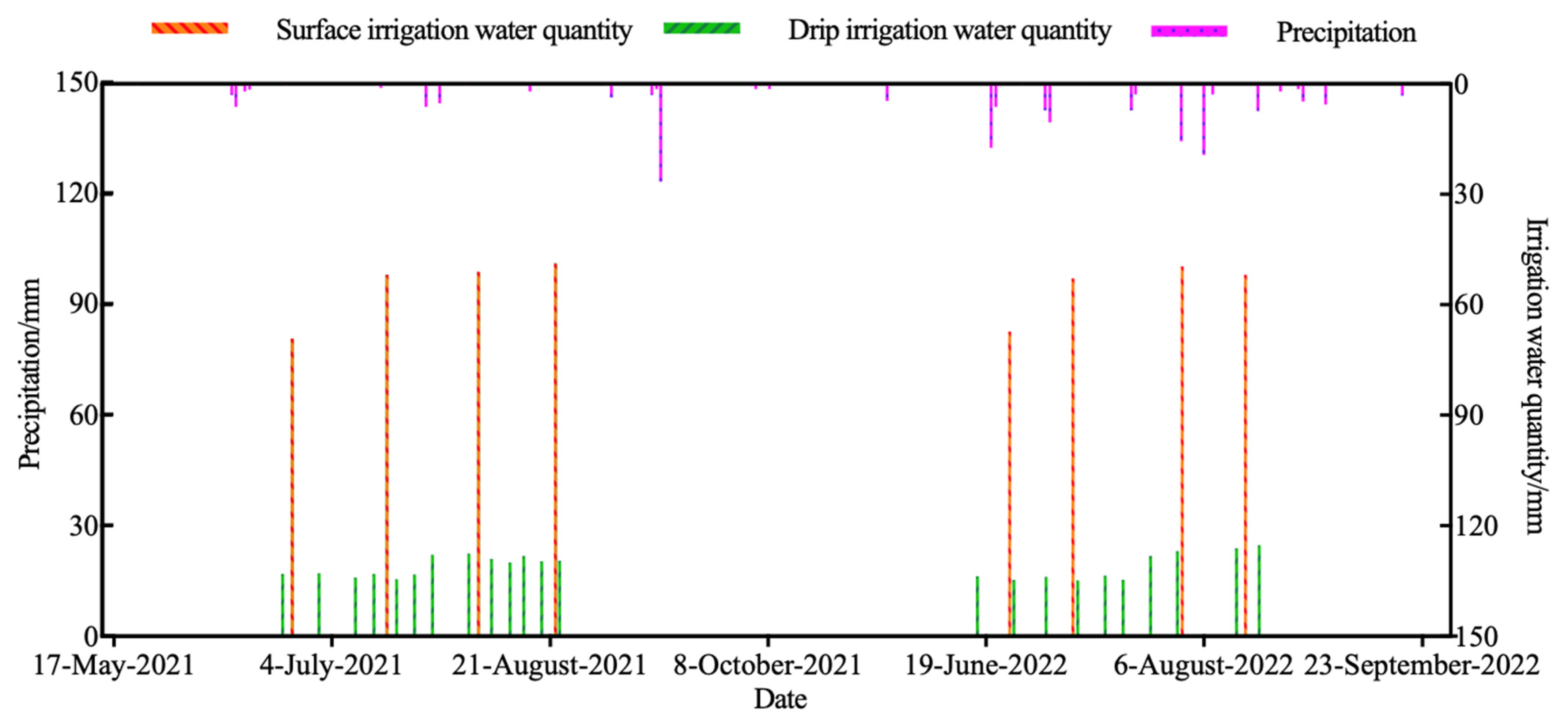
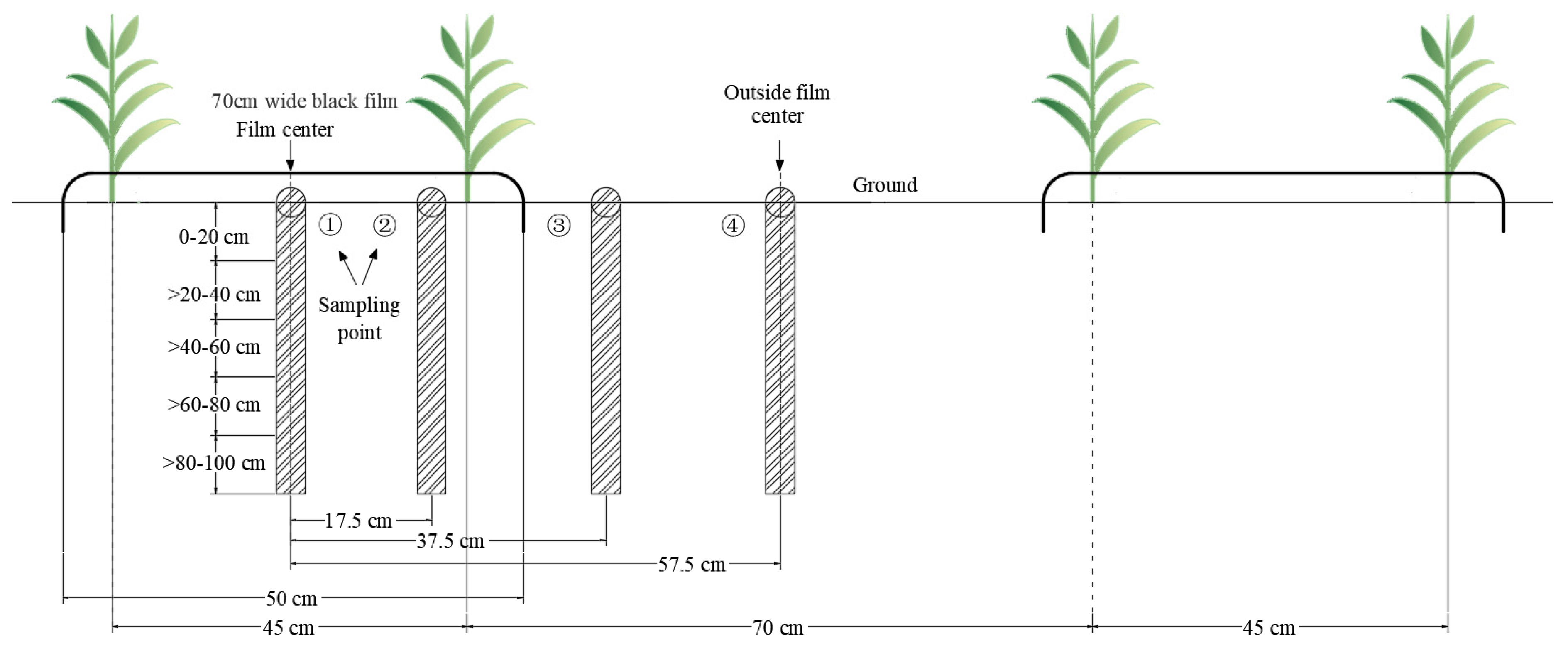
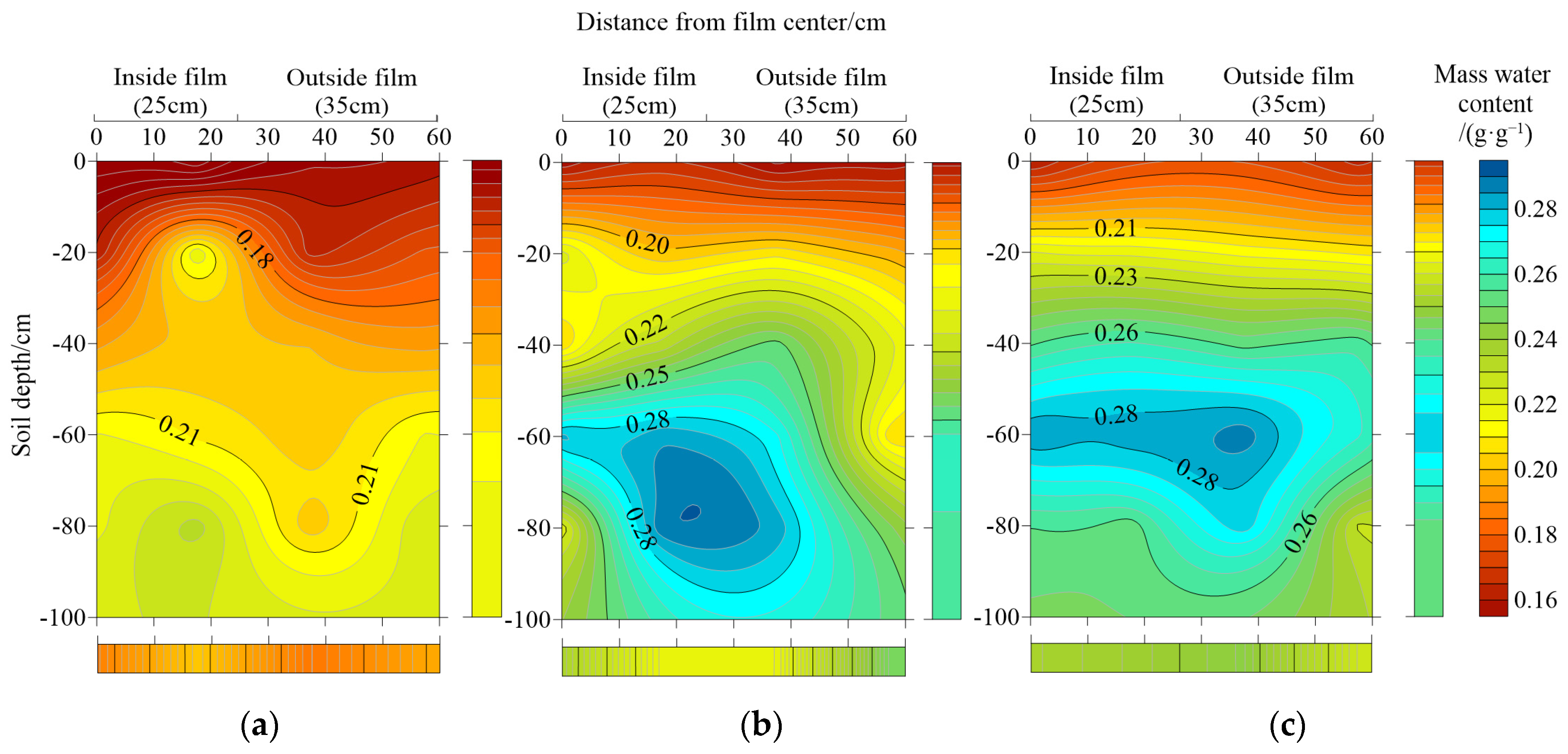
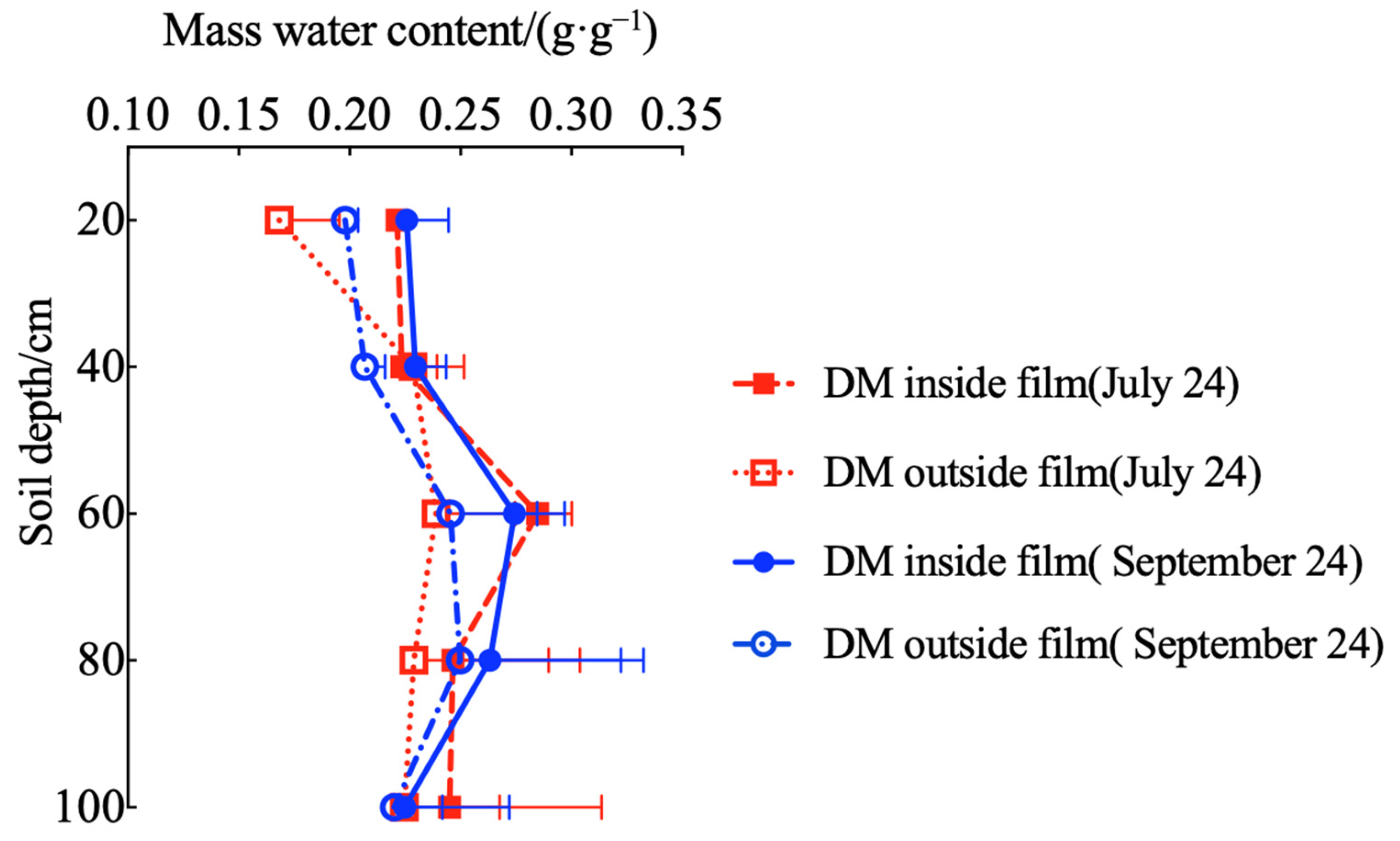

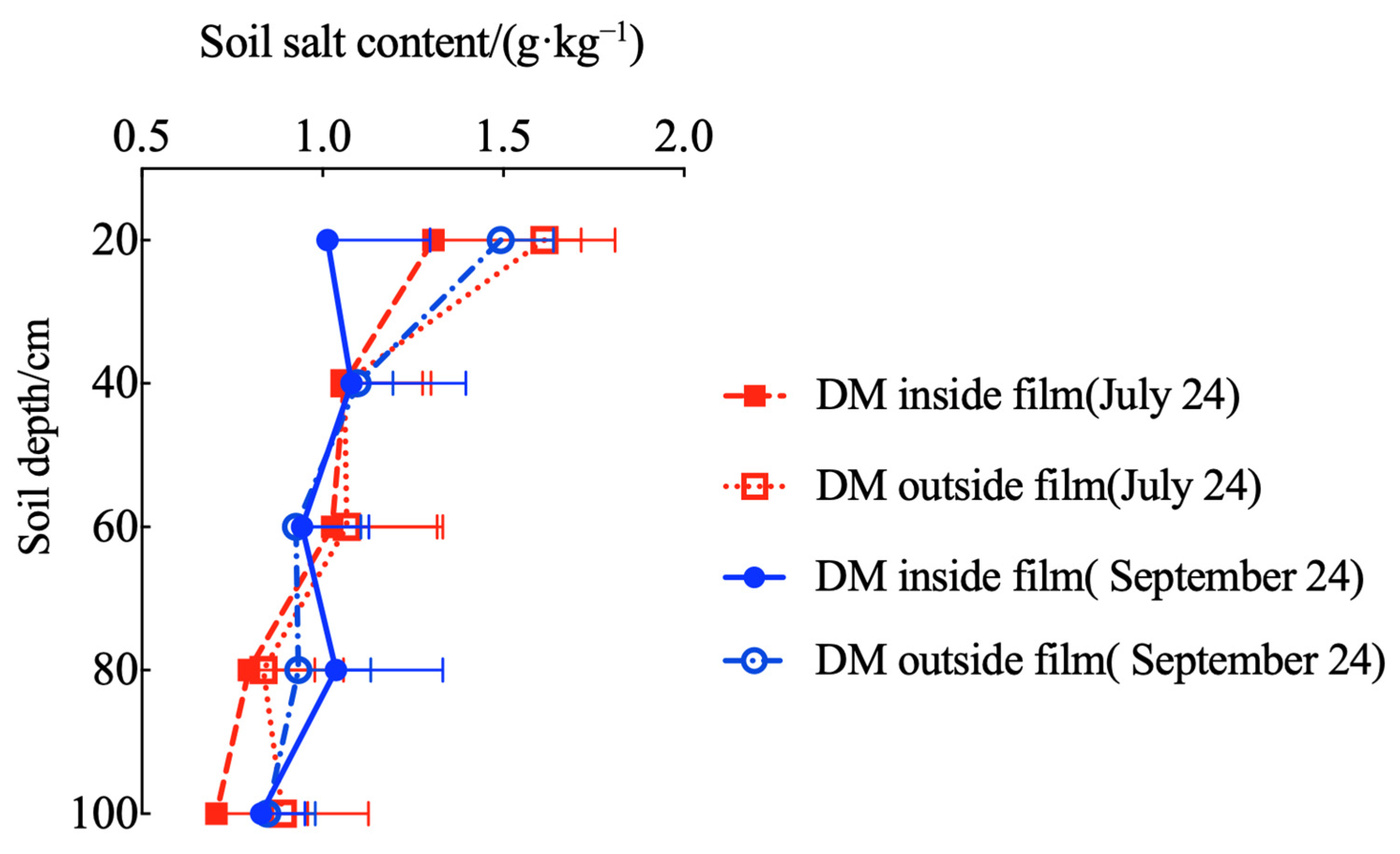

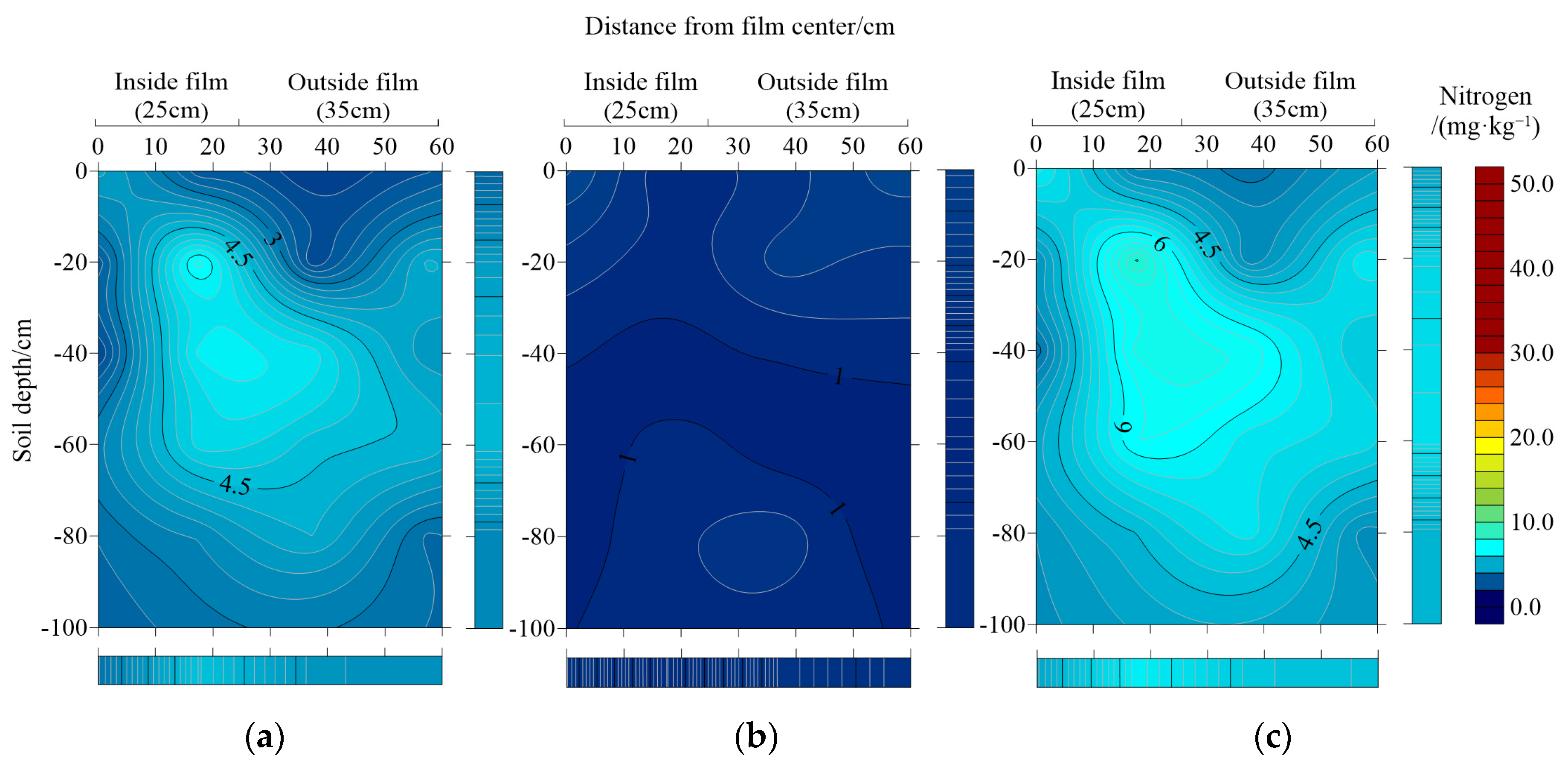
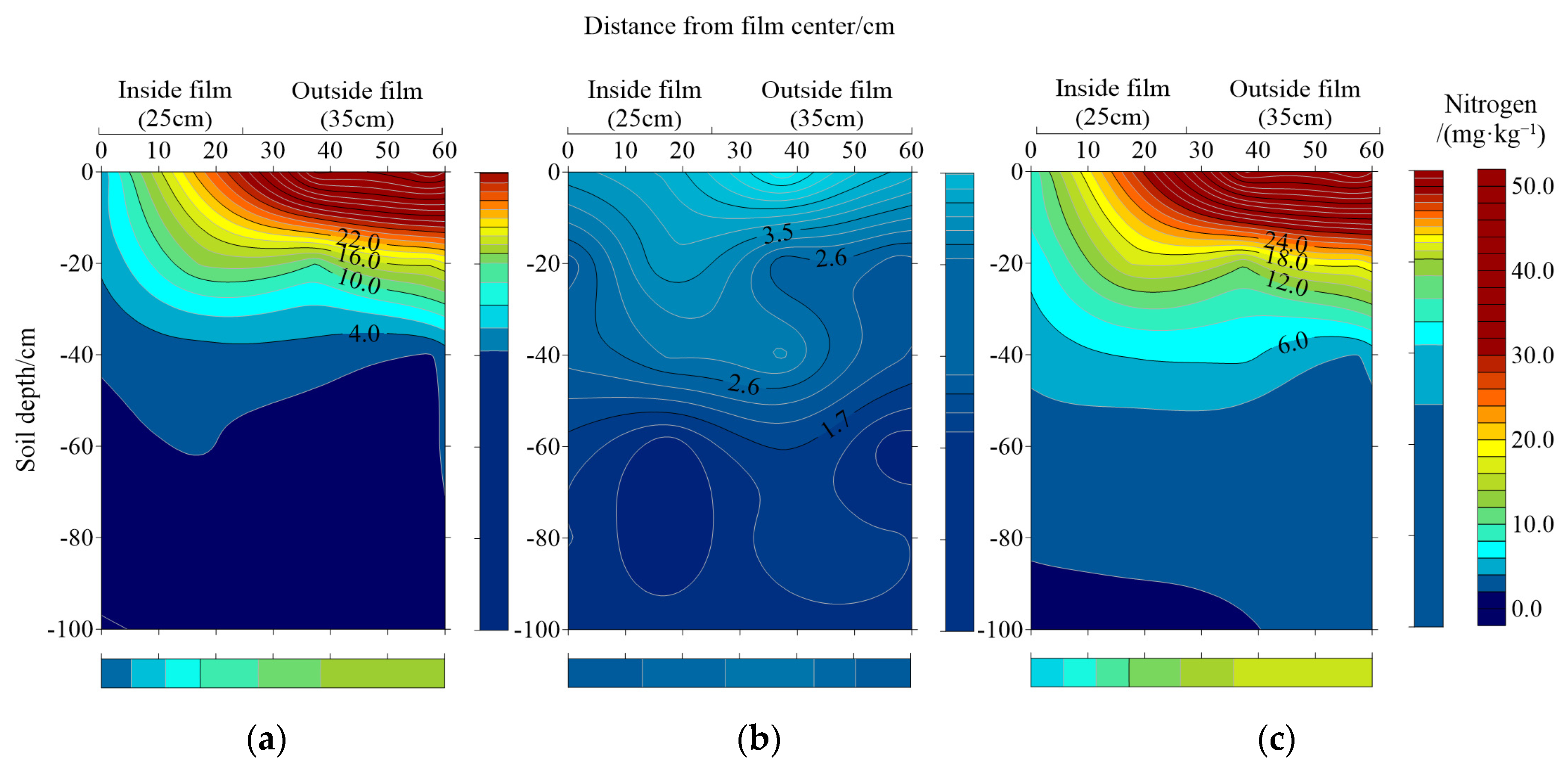
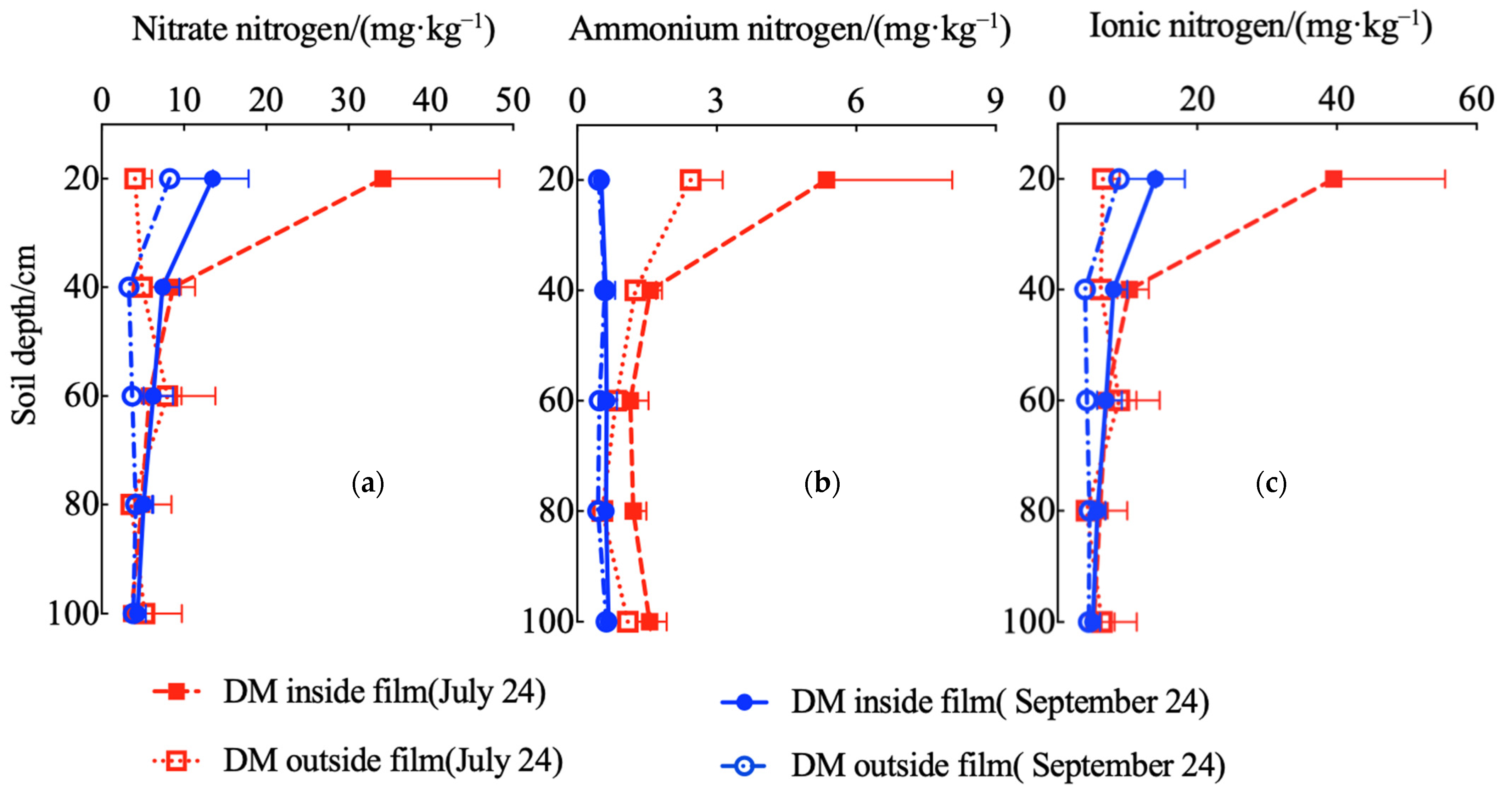
| Soil Depth/cm | Salt Content/ (g·kg−1) | Nitrate Nitrogen/ (mg·kg−1) | Ammonium Nitrogen/ (mg·kg−1) | Ionic Nitrogen/ (mg·kg−1) | pH |
|---|---|---|---|---|---|
| 0–20 | 2.98 | 6.60 | 4.77 | 11.37 | 8.42 |
| 20–40 | 2.68 | 2.52 | 3.97 | 6.49 | 8.47 |
| 40–60 | 1.88 | 1.30 | 1.91 | 3.21 | 8.98 |
| 60–80 | 1.22 | 0.30 | 1.10 | 1.40 | 9.04 |
| 80–100 | 0.99 | 0.42 | 1.20 | 1.62 | 8.97 |
| Seasons | Surface Irrigation | Drip Irrigation | ||
|---|---|---|---|---|
| Date | Nitrogen Application Rate/ (kg·ha−1) | Date | Nitrogen Application Rate/ (kg·ha−1) | |
| 2021 | 1 July 2021 | 38.0 | 23 June 2021 | 33.6 |
| 17 July 2021 | 39.0 | 9 July 2021 | 36.4 | |
| 5 August 2021 | 57.0 | 18 July 2021 | 43.1 | |
| 22 August 2021 | 57.0 | 26 July 2021 | 46.2 | |
| 12 August 2021 | 36.7 | |||
| 2022 | 25 June 2022 | 38.0 | 25 June 2022 | 30.6 |
| 9 July 2022 | 39.0 | 2 July 2022 | 7.7 | |
| 1 August 2022 | 57.0 | 9 July 2022 | 38.0 | |
| 15 August 2022 | 57.0 | 25 July 2022 | 65.2 | |
| 13 August 2022 | 51.7 | |||
| Seasons | Month | Mean Temperature (°C) | Mean Relative Humidity (%) | Mean Net Radiation (W m−2) | Mean Wind Speed (m s−1) | Monthly Rainfall (mm) |
|---|---|---|---|---|---|---|
| 2021 | June | 22.42 | 46.19 | 157.19 | 0.93 | 0.44 |
| July | 26.79 | 65.65 | 269.56 | 1.76 | 16.20 | |
| August | 22.87 | 65.23 | 229.46 | 1.62 | 3.80 | |
| September | 20.38 | 64.70 | 185.87 | 1.58 | 44.40 | |
| 2022 | June | 25.11 | 46.64 | 226.89 | 1.98 | 24.80 |
| July | 25.38 | 62.67 | 200.81 | 1.86 | 28.80 | |
| August | 24.42 | 71.92 | 176.77 | 1.70 | 54.00 | |
| September | 19.26 | 55.53 | 173.27 | 1.67 | 8.80 |
Disclaimer/Publisher’s Note: The statements, opinions and data contained in all publications are solely those of the individual author(s) and contributor(s) and not of MDPI and/or the editor(s). MDPI and/or the editor(s) disclaim responsibility for any injury to people or property resulting from any ideas, methods, instructions or products referred to in the content. |
© 2023 by the authors. Licensee MDPI, Basel, Switzerland. This article is an open access article distributed under the terms and conditions of the Creative Commons Attribution (CC BY) license (https://creativecommons.org/licenses/by/4.0/).
Share and Cite
Liu, H.; Ju, W.; Shao, M.; Hou, L. Investigation of Salt and Nitrogen Distribution under Belt Plastic Film Mulching in Surface- and Drip-Irrigated Maize Field in Hetao Irrigation District. Water 2023, 15, 2755. https://doi.org/10.3390/w15152755
Liu H, Ju W, Shao M, Hou L. Investigation of Salt and Nitrogen Distribution under Belt Plastic Film Mulching in Surface- and Drip-Irrigated Maize Field in Hetao Irrigation District. Water. 2023; 15(15):2755. https://doi.org/10.3390/w15152755
Chicago/Turabian StyleLiu, Haijun, Wenwen Ju, Mengxuan Shao, and Lizhu Hou. 2023. "Investigation of Salt and Nitrogen Distribution under Belt Plastic Film Mulching in Surface- and Drip-Irrigated Maize Field in Hetao Irrigation District" Water 15, no. 15: 2755. https://doi.org/10.3390/w15152755





